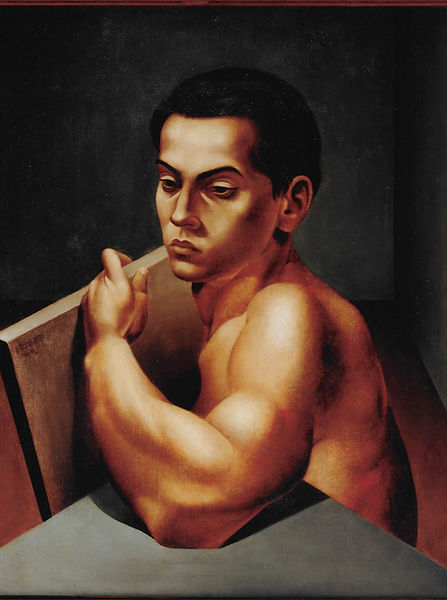STORY OF AN AMERICAN ARTIST
Post-Surrealism
The controversial event of Bloc of Painters, as well as positive critical acclaim for from other exhibits, brought Lehman into the spotlight. In 1933, Siqueiros left Los Angeles. Seeking a new mentor Lehman began studying under the tutelage of Lorser Feitelson at the Stickney Memorial School of Art in Pasadena, as well as at his Hollywood studio.
Both he and his high school pal, Phil Goldstein (aka Phil Guston) were influenced by Feitelson and had a 2-man show at the Stanley Rose Gallery in Hollywood. Reviewing the exhibit, Los Angeles Times art critic Arthur Millier wrote about the influence that Feitelson had on a group of young artists at the time. "One after another I encounter young artists who have learned from his Shop of knowledge, secrets of drawing and painting which help their own works to blossom. Harold Lehman is one of these."
Later in the article he reviews the 2-man show exhibit at the Stanley Rose Gallery in Hollywood.
The connoisseur of drawing should run swiftly to secure Mr. Lehman's pencil study of a sleeping woman, an exquisite thing, graceful, expressive and unmannered. His drawings show Lehman to be a sensitive artist, reverencing and understanding the drawing of the masters...[He also shows]a self portrait which, in its simplicity and honesty, might stand as a portrait of the young artists of this generation." (Self Portrait, 1933.)
Lehman's greatest influences came from Michelangelo, El Greco, Piero dello Francesca, Rembrandt, and Chinese and African sculpture. Among the modern surrealists, he admired the work of Pablo Picasso and Giorgio de Chirico. Total abstraction did not appeal to him.
In 1934, Salvador Dali had just had his first exhibit in the United States. He stirred up much interest and publicity. During this time, Lehman bought a small book written by Dali called Conquest of the Irrational which contained many illustrations of Dali's best work. Concurrently, he was also reading Freud and the Gestalt School of psychologists. The essence of Gestalt was figure-ground relationships.
According to Lehman, "this fit right in with the Surrealist practice of ambiguity and ways of seeing reality. All this appealed to me as a new means of expression and when Feitelson claimed to be taking Surrealism one step further, I was ready for it."
By 1934 when Lehman painted his first Surrealist picture, he was already quite knowledgeable about the development of painting. He had already done Renaissance style mural painting and frescos, and expressionist-realist oil painting.
In 1934 Lehman painted the Post-Surrealist work, Portrait of a Dancer Plus a Sculptor. It has since become an iconic painting representing Post-Surrealism, featured in many exhibits since 1995. Originally shown along with The Landlady at the San Diego Gallery of Fine Arts, the exhibit traveled to the Santa Barbara Museum and several other galleries in northern California.
In 1935, Lehman had his first one-man show at Jake Zeitlin's Gallery in Los Angeles. In a Los Angeles Times review (7/29/34), Arthur Millier writes: "It's worth the trip down to see what our artists are doing." He goes on to say how Portrait of a Dancer and Sculptor is one of the two most commented works in the show; "...a huge 'super-realistic' canvas by Harold Lehman".
By the end of 1935, Lehman was included in the first issue of Who's Who in American Art.
Ironically, because Lehman moved back to New York later that year, he was not included in the 1935 exhibition at the San Francisco Museum of Art, which according to Susan Anderson, curator of the exhibit Pacific Dreams: Currents of Surrealism and Fantasy in California Art, 1934-1957, "brought national recognition" to the other members of the Post-Surrealist group.
Next chapter: PWPA & Wiggins Trade School Mural
Related Articles
-
Pacific Dreams: Currents of Surrealism and Fantasy in California Art, 1934-1957, by UCLA at the Armand Hammer Museum of Art and Cultural Center, Oakland Museum, et al. (c) 1995
-
Surrealism USA. Peter Blume, Arshile Gorky, André Masson, Kay Sage. (c) 2005.
-
Lorser Feitelson. LorserFeitelson.com

Self Portrait, 1933. Harold Lehman, Los Angeles, CA.

Self Portrait, 1935. Harold Lehman, Los Angeles, CA.
